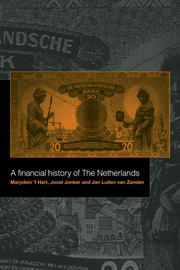Book contents
- Frontmatter
- Contents
- List of figures
- List of tables
- The Republic of the Seven United Provinces
- The Kingdom of the Netherlands
- 1 Introduction
- 2 The merits of a financial revolution: public finance, 1550–1700
- 3 Linking the fortunes: currency and banking, 1550–1800
- 4 From fragmentation to unification: public finance, 1700–1914
- 5 The alternative road to modernity: banking and currency, 1814–1914
- 6 Old rules, new conditions, 1914–1940
- 7 Towards a new maturity, 1940–1990
- 8 Conclusion
- Glossary
- Bibliography
- Index
4 - From fragmentation to unification: public finance, 1700–1914
Published online by Cambridge University Press: 03 February 2010
- Frontmatter
- Contents
- List of figures
- List of tables
- The Republic of the Seven United Provinces
- The Kingdom of the Netherlands
- 1 Introduction
- 2 The merits of a financial revolution: public finance, 1550–1700
- 3 Linking the fortunes: currency and banking, 1550–1800
- 4 From fragmentation to unification: public finance, 1700–1914
- 5 The alternative road to modernity: banking and currency, 1814–1914
- 6 Old rules, new conditions, 1914–1940
- 7 Towards a new maturity, 1940–1990
- 8 Conclusion
- Glossary
- Bibliography
- Index
Summary
Introduction
The decisive event in the financial history of The Netherlands during the eighteenth and the nineteenth centuries is the transformation from fragmentation to unification. After the so-called Batavian Revolution of 1795 the provincial debts of the united provinces were amalgamated into one national debt. The first national budget was presented to an elected parliament. In 1806 a national taxation system was realised, by which the fiscal autonomy of the seven provinces was ended. Moreover, the charters of the West and East Indian Companies were not renewed after their expiration. Their tasks were handed over to a state department of colonial affairs. The local Bank of Amsterdam died a silent death in 1820 and a new national bank modelled on the example of the Bank of England was erected in 1814. In the meantime, the pound sterling had taken over the role of the depreciated Bank of Amsterdam guilder as the main international key currency at the turn of the century. London replaced Amsterdam as the main international financial centre (see chapter 3). Thus, the Dutch lead in the international financial and economic system definitely came to an end, the ancien regime federal republic became a modern unitary state, ready to embark on financial policy on a national scale.
In the seventeenth century the Dutch Republic had been remarkable for the success of its financial system. In the beginning of the eighteenth century its debts were hardly any longer compatible with its small size. Owing to their central position in the international system, however, the Dutch could not back out silently.
- Type
- Chapter
- Information
- A Financial History of the Netherlands , pp. 64 - 93Publisher: Cambridge University PressPrint publication year: 1997
- 10
- Cited by



